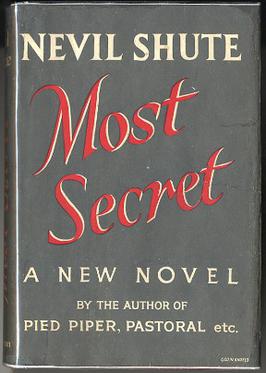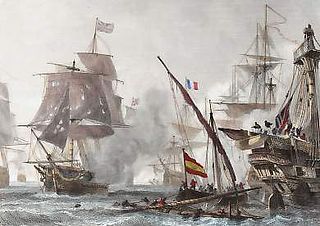
The Battle of Trafalgar was a naval engagement that took place on 21 October 1805 between the British Royal Navy and the combined fleets of the French and Spanish Navies during the War of the Third Coalition of the Napoleonic Wars (1803–1815).
Horatio Hornblower is a fictional officer in the British Royal Navy during the Napoleonic Wars, the protagonist of a series of novels and stories by C. S. Forester. He later became the subject of films and radio and television programmes, and C. Northcote Parkinson elaborated a "biography" of him, The True Story of Horatio Hornblower.

The Battle of the Falkland Islands was a First World War naval action between the British Royal Navy and Imperial German Navy on 8 December 1914 in the South Atlantic. The British, after their defeat at the Battle of Coronel on 1 November, sent a large force to track down and destroy the German cruiser squadron. The battle is commemorated every year on 8 December in the Falkland Islands as a public holiday.
John "Jack" Aubrey, is a fictional character in the Aubrey–Maturin series of novels by Patrick O'Brian. The series of novels portrays his rise from lieutenant to rear admiral in the Royal Navy during the Napoleonic Wars. The twenty -book series encompasses Aubrey's adventures and various commands along his course to flying a rear admiral's flag.

Captain Blood: His Odyssey is an adventure novel by Rafael Sabatini, originally published in 1922.

Post Captain is the second historical novel in the Aubrey–Maturin series by Patrick O'Brian, first published in 1972. It features the characters of Captain Jack Aubrey and naval surgeon Stephen Maturin, and is set in the early 19th century during the Napoleonic Wars.

The Fortune of War is the sixth historical novel in the Aubrey–Maturin series by British author Patrick O'Brian, first published in 1979. It is set during the War of 1812 and much of the story takes place in Boston, Massachusetts.

HMS Royal Sovereign was a 100-gun first-rate ship of the line of the Royal Navy, which served as the flagship of Admiral Collingwood at the Battle of Trafalgar. She was the third of seven Royal Navy ships to bear the name. She was launched at Plymouth Dockyard on 11 September 1786, at a cost of £67,458, and was the only ship built to her design. Because of the high number of Northumbrians on board the crew were known as the Tars of the Tyne.

The Midnight Folk is a children's fantasy novel by John Masefield first published in 1927. It is about a boy, Kay Harker, who sets out to discover what became of a fortune stolen from his seafaring great grandfather Aston Tirrold Harker. The treasure is also sought by a coven of witches who are seeking it for their own ends. Kay's governess Sylvia Daisy Pouncer is a member of the coven. The witches are led or guided by the wizard Abner Brown.

Hornblower in the West Indies, or alternately Admiral Hornblower in the West Indies, is one of the novels in the series that C. S. Forester wrote about fictional Royal Navy officer Horatio Hornblower.

The Brazilian Naval Revolts, or the Revoltas da Armada, were armed mutinies promoted mainly by admirals Custódio José de Melo and Saldanha da Gama and their fleet of rebel Brazilian navy ships against the claimed unconstitutional staying in power of president Floriano Peixoto.

The Battle of Santa Cruz de Tenerife was an amphibious assault by the Royal Navy on the Spanish port city of Santa Cruz de Tenerife in the Canary Islands. Launched by Rear-Admiral Horatio Nelson on 22 July 1797, the assault was defeated, and on 25 July the remains of the landing party withdrew under a truce, having lost several hundred men. Nelson himself had been wounded in the arm, which was subsequently partially amputated: a stigma that he carried to his grave as a constant reminder of his failure.

Most Secret is a novel by English writer Nevil Shute, written in 1942 but censored until 1945, when it was published by Heinemann. It is narrated by a commander in the Royal Navy, and tells the story of four officers who launch a daring mission at the time when Britain stood alone against Germany after the fall of France. Genevieve is a converted French fishing vessel, manned by four British officers and a small crew of Free French ex-fishermen, armed only with a flame thrower and small arms. Their task is as much psychological as military: to show the Germans that they will one day be beaten back.

Sard Harker (1924) by John Masefield (1878–1967) is an adventure novel first published in October 1924. It is the first of three novels by Masefield set in the fictional nation of Santa Barbara in South America. The others are ODTAA and The Taking of the Gry.

HMS Philomel, later HMNZS Philomel, was a Pearl-class cruiser. She was the fifth ship of that name and served with the Royal Navy. After her commissioning in 1890, she served on the Cape of Good Hope Station and later with the Mediterranean Fleet.

HMS Tribune was a Royal Navy 36-gun fifth rate. This frigate was originally the French Galathée-class frigateCharente Inférieure, which was launched in 1793 during the French Revolutionary Wars and renamed Tribune the next year. The British captured her and took her into service with the Royal Navy. She only served for a year before being wrecked off Herring Cove, Nova Scotia, on 16 or 23 November 1797. Of the 240 men on board, all but 12 were lost.

Charles Lydiard was an officer of the Royal Navy who served during the French Revolutionary and Napoleonic Wars.

The First Battle of Algeciras was a naval battle fought on 6 July 1801 between a squadron of British Royal Navy ships of the line and a smaller French Navy squadron at anchor in the fortified Spanish port of Algeciras in the Strait of Gibraltar. The British outnumbered their opponents, but the French position was protected by Spanish gun batteries and the complicated shoals that obscured the entrance to Algeciras Bay. The French squadron, under Contre-Amiral Charles Linois, had stopped at Algeciras en route to the major Spanish naval base at Cadiz, where they were to form a combined French and Spanish fleet for operations against Britain and its allies in the French Revolutionary Wars. The British, under Rear-Admiral Sir James Saumarez, sought to eliminate the French squadron before it could reach Cadiz and form a force powerful enough to overwhelm Saumarez and launch attacks against British forces in the Mediterranean Sea.

The Rio de Janeiro Affair refers to a series of incidents during the Brazilian Naval Revolt in January 1894. Following three attacks on American merchant ships in the harbour of Rio de Janeiro, a bloodless naval engagement occurred between a United States Navy warship and an ironclad of Rear Admiral Saldanha da Gama's rebel fleet. Ultimately the Americans completed their objective, and Gama offered to surrender his fleet to the Americans, but the offer was never pursued.

Dainty was an English race-built galleon that began to be built in 1588. The original name was Repentance, but this was soon changed. It participated in some naval engagements in the Anglo-Spanish War (1585–1604). In 1593 it sailed from England under Richard Hawkins to navigate the Pacific Ocean and circumnavigate the world, but was captured the following year by the Spaniards when it was sailing off the coast of what is now Ecuador. It was commissioned by the Spaniards as Nuestra Señora de la Visitación, serving in the South Pacific for several years. She was also known informarly by her nickname, La Inglesa.


















